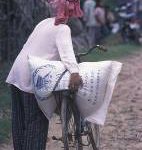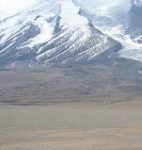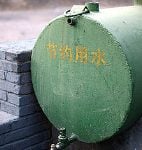June has been a hectic month for Lester R Brown, president and founder of the Washington-based Earth Policy Institute. While launching versions of his Plan B 3.0 — subtitled “Mobilising to Save Civilisation” — in Chinese, Hindi and four other languages — Brown also is keeping well abreast of the “fast-unfolding food shortage’’ that is “engulfing the entire world, driving food prices to record highs”.
In reviewing the English-language version of the book, published in January, chinadialogue noted that Brown “doesn’t just write books about the environmental challenges facing the planet. He rewrites and updates them in a race both to keep up with the speed of changes and to persuade the world to pay attention before it is too late.” Spelling out his plan for human survival in Plan B 3.0, Brown argued that four main goals need to be addressed urgently and simultaneously: to stabilise climate, stabilise population, eradicate poverty and restore the planet’s damaged ecosystems.
Failure of any one of those goals, he says, will mean the failure of all of them – and Brown is determined not to let that happen. Ahead of the Chinese and other translations of Plan B 3.0, he already has issued updates on the Earth Policy Institute’s website. “Over the past half-century,” he wrote in April, “grain prices have spiked from time to time because of weather-related events, such as the 1972 Soviet crop failure that led to a doubling of world wheat, rice and corn prices.”
But today’s situation is entirely different, says Brown: “The current doubling of grain prices is trend-driven, the cumulative effect of some trends that are accelerating growth in demand and other trends that are slowing the growth in supply.”
“The world has not experienced anything quite like this before,” he continues. “In the face of rising food prices and spreading hunger, the social order is beginning to break down in some countries.” Pointing to rice-rustling in Thailand, hijackings of United Nations grain trucks in Sudan, food insecurity in Pakistan and violence in countries including Egypt, Morocco, Yemen, Cameroon, Brown asserts that “a politics of food scarcity is emerging” around the world.
“Most fundamentally,” according to Brown’s update, “it involves the restriction of grain exports by countries that want to check the rise in their domestic prices” – countries such as Russia, Ukraine, Argentina, Vietnam and Cambodia. Such export restrictions serve to drive up prices in a tight world market. Both supply and demand, he says, are being affected by the cumulative effect of several well-established trends.
“The challenge is not simply to deal with a temporary rise in grain prices, as in the past, but rather to quickly alter those trends whose cumulative effects collectively threaten the food security that is a hallmark of civilisation,” Brown asserts. “If food security cannot be restored quickly, social unrest and political instability will spread and the number of failing states will likely increase dramatically, threatening the very stability of civilisation itself.”
“On the demand side,” he says, “the trends include the continuing addition of 70 million people per year to the earth’s population, the desire of some 4 billion people to move up the food chain and consume more grain-intensive livestock products, and the sharp acceleration in the US use of grain to produce ethanol for cars.” (Annual growth in world grain consumption has risen from “roughly 20 million tons to 50 million tons” since 2005 due to ethanol demands, Brown says.)
On the supply side, he continues, “there is little new land to be brought under the plow unless it comes from clearing tropical rainforests in the Amazon and Congo basins and in Indonesia, or from clearing land in the Brazilian cerrado”, a savanna-like region. That, of course, has heavy environmental costs, including the release of sequestered carbon, animal- and plant-species loss, increased runoff from rainfall and soil erosion. Elsewhere, cropland has been devoured by construction, roads, highways and parking lots.
Even scarcer than new land are new sources of water for irrigation. Grainland productivity increases are slowing down. Higher oil prices drive up the costs of both food production and transportation, making biofuel (particularly ethanol production) a more profitable business option for grain growers.
“Beyond this, climate change presents new risks,” writes Brown. “Crop-withering heat waves, more destructive storms, and the melting of the Asian mountain glaciers that sustain the dry-season flow of that region’s major rivers are combining to make harvest expansion more difficult.”
In an update in March, Brown addressed that issue specifically. “Mountain glaciers in the Himalayas and on the Tibet-Qinghai plateau are melting,” he wrote, “and could soon deprive the major rivers of India and China of the ice melt needed to sustain them during the dry season. In the Ganges, the Yellow and the Yangtze river basins, where irrigated agriculture depends heavily on rivers, this loss of dry-season flow will shrink harvests.” The International Panel on Climate Change (IPCC) has reported that many of the Himalayan glaciers are receding so quickly that they could melt entirely by 2035.
The situation is critical: in Brown’s words, “the world has never faced such a predictably massive threat to food production” as that posed by the melting Asian glaciers. “China and India are the world’s leading producers of both wheat and rice – humanity’s food staples,” he writes. If the Gangotri Glacier, which supplies 70% of the flow of the Ganges during the dry season, vanishes, the river could become seasonal. It would flow during the rainy season, says Brown, but not during the dry season – when irrigation water needs are greatest. A similar situation faces the Yellow and the Yangtze rivers by 2060, leading to “an ecological catastrophe”, believes Chinese glaciologist Yao Tandong.
And there are other problems, now and ahead: overpumping of water is depleting underground resources; wells are drying up; politically unmanageable food shortages loom large; populations are growing. By 2050, India is projected to have 490 million more people, China 80 million more.
Given the current grain situation, Brown noted in March, any disruption of Chinese and Indian wheat and rice harvests because of water shortages “will greatly affect not only people living there but consumers everywhere”. China and India may even end up competing with Americans for the US grain harvest.
“The glaciologists have given us a clear sense of how fast glaciers are shrinking,” writes Brown. “The challenge now is to translate their findings into national energy policies designed to the save the glaciers. At issue is not just the future of mountain glaciers, but the future of world grain harvests.”
Brown’s message to China and India this month, as their people get the opportunity to consume Plan B 3.0 in Chinese and Hindi, is “to abandon business-as-usual energy policies” and move to cut carbon emissions – which contribute to climate change — by 80% by 2020. The first step, he says, is to ban new coal-fired power plants – an idea that is catching fire in the United States. And which two countries are planning to build most of those new plants? China and India — “precisely the ones whose food security is most massively threatened by the carbon emitted from burning coal”.
“It is now in their interest to try and save their mountain glaciers by shifting energy investment” to wind, solar and geothermal power, says Brown. “At issue is whether we can mobilise to lower atmospheric CO2 concentrations before high temperatures melt the mountain glaciers that feed the major rivers of Asia and elsewhere, and before shrinking harvests lead to an unraveling of our civilisation.”
World food security, Brown emphasises, will deteriorate further “unless leading countries can collectively mobilise to stabilise population, restrict the use of grain to produce automotive fuel, stabilise climate, stabilise water tables and aquifers, protect cropland and conserve soils.” Worldwide efforts need to focus of eradicating poverty and raising water productivity. Progress on all these fronts is essential, says Brown, and the good news, he believes, is that it can be done if we choose to do it.
Maryann Bird is associate editor of chinadialogue
homepage photo by Ngkkh



